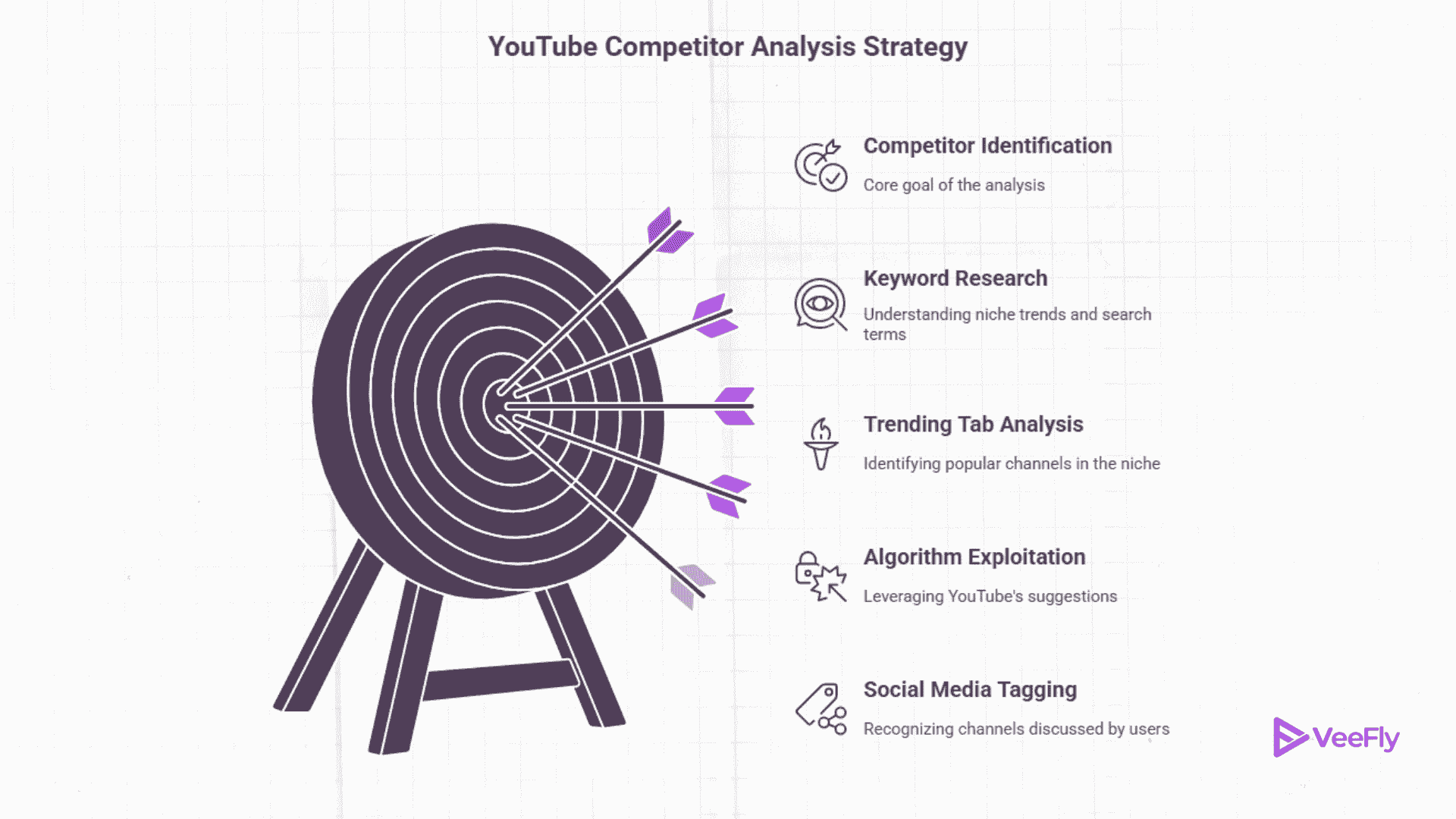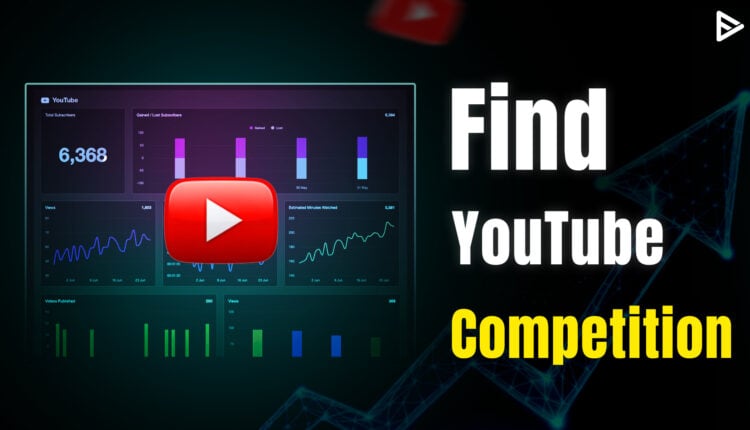Guessing games do not work on YouTube. Your content strategy needs to be backed by data. You can acquire data from the YouTube platform itself, such as trends, audience intent, viewers’ search intent, watch preference, etc. Although you have data, it doesn’t give a clear picture.
The best way to find optimal and relevant strategies is to do competitive analysis. In every niche, we can find the best YouTubers and barely surviving channels. We have to decode tricks from the best ones, and survivors will show us what not to do. The question is how to find competitors. If we are analyzing the best channels on YouTube. We’ll acquire the most practical and workable strategies. In this blog, we’ll discuss how to find competitors using the best tools of 2025.
What are YouTube Competitor Analysis Tools?
The tools track and compare the performance of other channels in your niche. For example, it can track subscriber count, subscriber growth rate, views, engagement rate, upload frequency, use of ranked keywords, content formats, etc.
The data gives you insights, and you can make sense out of it. You’ll know what is working for the performing channels and what you and other channels are lacking. Additionally, you can spot gaps in your content, track trends relevant to your niche, and improve the SEO of your channel.
All these will help you analyse and redefine your own channels content strategy, thus resulting in better engagement.
4 YouTube Competitors Analysis Tools of 2025
Let’s see how to find competitors within your niche using the analysis tools of 2025.
TubeBuddy
The tool has been serving the YouTube space for more than a decade. The tool highlights are that you find relevant keywords, test thumbnails, and compare videos (Performing vs Non-Performing). It also has an alert feature so that whenever your marked channels upload a video, you get an alert notification.
Tubebuddy is a freemium tool. In free ones, you can get keyword research, suggested tags, limited video SEO insights, browser extension, and paid features, such as advanced keyword analyzer, A/B testing, bulk card, competition analysis, video plan, priority, advanced analytics, etc.
VidiQ
The key features of VidiQ include receiving alerts on your competitors keywords, SEO cards, and engagement analytics. The tools primarily focus on SEO and content insights. Which creators can use to rank higher in the YouTube search results?
Social Blade
The tool is famously known for being compatible with YouTube as well as other social media platforms(Instagram, Twitch, TikTok, Facebook, etc).
Social Blade can identify trends of audience engagement, give predictions for earnings, and provide real-time data on top-performing creators in your niche.
Brand24
Brand24 has to offer some unique features, such as sentiment analysis, influencer analysis, content reach, and real-time alerts. The tool is prominent for marketers or YouTube growth managers to analyse positive mentions. You can find out with whom your competitors are collaborating, and the reach of competitors content.
How to Find Competitors without Using Tools
Now that we have seen how to find competitors using the top tools. Let’s see how you can do competitor analysis without any tools.

Start with keyword research
You can find out what people are searching for in your niche using Google Trends, YouTube Studio, or Ask Studio AI. Type words related to your niche in the YouTube search bar, and you can see the list of words people are searching for.
Trending Tab
Just go to the trending tab and analyze your niche. Open each channel’s homepage and see what they are doing. Channels that consistently appear in trends can be used as primary competitors.
Make the algorithm work for you
You can like and subscribe to videos and channels that you think are best in your niche. The algorithm will suggest related channels. You can pick out things that are relevant to your channel.
Most tagged or discussed channel
Start by exploring YouTube channels that are tagged by many users on social media. Categorize them according to popularity. For example, MrBeast is heavily tagged by people, so this channel is irrelevant if you have 10K to 50K subscribers.
Things Every YouTube Competitor Does
We discussed how to find competitors using tools and organic search methods. Let’s see some of the practices that every YouTube channel does, and you should too.
Promoting YouTube Video
It’s a common practice in the YouTube community to promote your videos. The promotion helps you get ahead of the crowd by using targeted ads, and your videos are seen by relevant people on YouTube. Once your target audience sees it, the chances of YouTube growth increase.
YouTube SEO
It is a must-do! You can’t skip the YouTube SEO. The metadata is generated based on SEO, and this metadata is understood by the algorithm. This helps your videos appear in search engines, YouTube search results, recommendations, etc. Additionally, the content is also suggested for the relevant device type. For example, if you upload longer videos, the TV audience is targeted, and for Shorts, mobile users.
Tracking performance
The metrics give a clear indication of your channel’s success. Whether you have done organic or paid promotion, it can easily be tracked. The Studio Analytics tools, such as Ask Studio AI, use your data and suggest ideas and content strategies based on your channel audience. Most importantly, the metrics such as impressions, clicks, watch time, source, CTR, unique viewers, shopping, etc, give you context to create a content strategy.
Conclusion
The competitor analysis gives you a perspective on what your channel is lacking and its strengths. In the blog, we discussed how to find YouTube competitors. First, we saw the 4 trending YouTube competitor analysis tools (TubeBuddy, VidiQ, SocialBlade, Brand 24). Using tools makes it easy to acquire in-depth data to form a content strategy. However, if you are just starting, you can do competitor analysis without tools using the methods mentioned above. At last, we talked about three practices that must be done by every YouTube creator.
Frequently Asked Questions
Q1. Can ChatGPT analyze my YouTube channel?
No, you can’t directly analyze other videos on YouTube and get data. However, you can use ChatGPT for video creation, generate niche ideas, and discover popular channels in a specific niche. Generate transcript, and many more GenAI things.
Q2. How to find the competition?
Do market analysis to find the target audience, collect feedback, find top niche competitors using search results, and browse social media and forums to see the most talked-about competitors.
Q3. Which tool is the best YouTube competitor analysis tool?
Google Trends, semrush, Tubebuddy, YouTube Search Bar, etc. You can find the channels, get the data, and use AI tools to identify the patterns that are beneficial for you.
Q4. Is the YouTube competitor analysis tools free?
Yes, most of them are free, such as Google Trends and the YouTube Ask Studio AI. However, for advanced YouTube competitor analysis, you can use the premium version of tools like TubeBuddy or VidIQ.
Summary
- Data-driven content strategies are essential for success on YouTube.
- Competitive analysis helps identify effective strategies by examining successful and struggling channels.
- Key YouTube competitor analysis tools include TubeBuddy, VidiQ, Social Blade, and Brand24, each offering unique features.
- Competitor analysis can also be performed without tools through keyword research, analyzing trending channels, and leveraging YouTube's algorithm.
- Essential practices for YouTube creators include promoting videos, optimizing for YouTube SEO, and tracking performance metrics.


